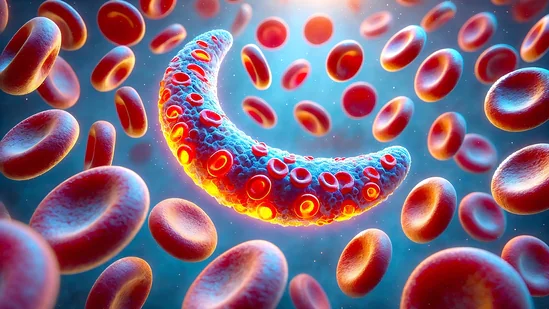
Sickle Cell Disease (SCD) is a serious genetic blood disorder that affects millions of people worldwide. Though it is most common in parts of Africa, India, the Middle East, and among people of African descent in the Americas, its impact knows no borders. The condition is chronic, often painful, and can affect virtually every system in the body. Yet, with early detection and proper management, individuals living with SCD can lead healthier, longer lives.
What Is Sickle Cell Disease?
Sickle Cell Disease is caused by a mutation in the gene that tells the body how to make hemoglobin, the protein in red blood cells that carries oxygen. Normally, red blood cells are round and flexible, allowing them to travel easily through blood vessels. But in SCD, some red blood cells become misshapen — like a crescent or sickle. These sickle-shaped cells are stiff and sticky. They clump together, blocking blood flow and reducing the oxygen supply to parts of the body.
This blockage can cause severe pain episodes, known as sickle cell crises. Over time, the condition can lead to complications such as anemia, organ damage, stroke, infections, and delayed growth in children.
Early Signs and Diagnosis
The first clues of SCD often appear in infancy or early childhood. A baby born with the disease typically looks healthy at birth but begins to show symptoms by 4 to 6 months of age. Early signs include:
- Swelling in the hands and feet
- Fatigue or fussiness
- Yellowing of the skin or eyes (jaundice)
- Frequent infections
A simple blood test, known as a hemoglobin electrophoresis, can confirm the diagnosis. Many countries now include newborn screening for SCD in standard health programs. Early diagnosis is crucial, as it allows parents and healthcare providers to begin preventive care and reduce the risk of complications.
The Genetic Link
Sickle Cell Disease is inherited. For a child to be born with SCD, both parents must carry the sickle cell trait — meaning they each pass on one copy of the faulty gene. If only one parent carries the gene, the child may inherit the trait but not the disease. People with the sickle cell trait are usually healthy but can pass the gene to their children.
Genetic counseling and testing play an important role in helping at-risk families understand the condition and make informed decisions about family planning.
Lifelong Impact and Complications
Living with SCD means facing challenges that go beyond physical health. The disease often interferes with education, employment, and social life due to frequent hospital visits and unpredictable pain episodes. Some common complications include:
- Chronic anemia: Because sickled cells die faster, the body can’t keep up with making new red blood cells.
- Pain crises: Intense pain in the chest, back, arms, or legs may require hospitalization.
- Stroke: Blocked blood flow can damage the brain, even in children.
- Acute chest syndrome: A life-threatening condition similar to pneumonia.
- Vision problems: Sickled cells can block blood vessels in the eyes.
The emotional and psychological toll is also significant. Children and adults with SCD often experience anxiety, depression, and feelings of isolation.
Treatment and Management
There is currently no universal cure for SCD, but several treatments can manage the symptoms and improve quality of life:
- Hydroxyurea: A medication that reduces the frequency of pain crises and the need for blood transfusions.
- Blood transfusions: Used to treat severe anemia or reduce stroke risk.
- Bone marrow transplant: The only potential cure, but it is not widely available and comes with serious risks.
- Pain management: Often requires a combination of medications, physical therapy, and support.
In addition, regular medical checkups, vaccines, antibiotics, and a healthy lifestyle can prevent complications.
Hope for the Future
Research in gene therapy offers promising hope for a cure. Recent clinical trials have shown success in correcting the faulty gene responsible for the disease. Meanwhile, advocacy and awareness campaigns continue to push for better access to care, especially in low-resource settings where the disease burden is highest.
Conclusion
Sickle Cell Disease is a complex condition that starts early and lasts a lifetime. But early detection and proper care can significantly reduce its impact. Greater awareness, better screening, and ongoing research are key to improving outcomes for those living with this challenging disease. As the world moves forward in healthcare innovation, there is real hope that future generations may no longer have to suffer from this painful disorder.
Thanks For Reading